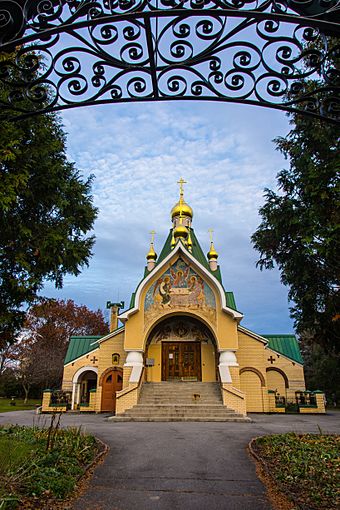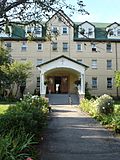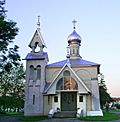Holy Trinity Monastery (Jordanville, New York) facts for kids
Quick facts for kids |
|
|
Holy Trinity Monastery
|
|

Holy Trinity Cathedral, main church of the Monastery
|
|
| Nearest city | 1407 Robinson Road, Jordanville, New York |
|---|---|
| Area | 750 acres (300 ha) |
| Architect | R.N. Verkovsky (Main Church), Dimitri Blachev (Chapel by the Lake) |
| NRHP reference No. | 09000286 |
| Added to NRHP | June 23, 2011 |
Holy Trinity Monastery is a special place for Russian Orthodox Christians in the West. It is a monastery for men, located near Jordanville, New York. Two Russian immigrants started it in 1930. Over time, it became a very important spiritual center for Russian Orthodoxy.
The monastery is also known for its publishing work. It has a school called Holy Trinity Orthodox Seminary. This school has trained many religious leaders for the Russian Orthodox Church Outside of Russia and other Orthodox groups. Because it is so close to the small town, people often just call the monastery and seminary "Jordanville." The monastery is named after the Holy Trinity. Its main celebration day is Pentecost. There is also a museum on the property that visitors can explore.
Contents
History of Holy Trinity Monastery
Starting a New Life
A monk named Panteleimon (Nizhnik) wanted to live a stricter religious life. He had spent ten years at another monastery. He also wanted to stay with the Russian Orthodox Church Outside of Russia (ROCOR) after a split in 1926. He shared his idea with Ivan Kolos, a choir director. They decided to find a place to live a "genuine monk's life."
They traveled to Herkimer County in Upstate New York. There, they bought the Starkweather farm near Jordanville. They paid $25 as a first payment. To pay off the rest, Panteleimon worked at the Sikorsky Airplane Factory. He was a wing mechanic in Stratford, Connecticut. Ivan Kolos stayed at his church.
Early Days and Challenges
In the spring of 1930, after Pascha, Father Panteleimon moved to the farm. Ivan Kolos and another monk, Father James, worked at the factory. They worked until the land was fully paid for. Life was very hard at first. They lived in a small building. They had a horse and a cow. Instead of a stove, they used hot stones to cook their food.
The monks performed their daily prayers. They also worked the land and started a dairy farm. A new monk, Father Ilya, was a carpenter. With his help, they built a large house. It had a chapel and rooms for sixteen monks. This building was finished in 1935.
A Fire and New Beginnings
Bishop Vitaly (Maximenko) blessed the new monastic building on June 17, 1935. But at the end of the church service, they smelled burning wood. Someone cried, "The church is afire!" Bishop Vitaly and the monks helped everyone get to safety. The building, worth $10,000, burned completely. It was not insured.
The monks found shelter in a wagon shed. They did not give up hope. They decided to build an even better place. The small group of monks soon bought another, larger house nearby. They also bought 200 more acres of land. They continued farming and dairy operations. They also got a printing press. They started publishing religious books. They even held a concert at a local church. Members of a nearby Baptist church visited the monastery.
Growth and New Monks
In 1946, fourteen new monks arrived at Jordanville. They were led by Bishop Seraphim (Ivanov). Among them was Laurus (Škurla), who would later become a Metropolitan. This group had been living at the St. Job of Pochaev Monastery in Ladomirová, Czechoslovakia. Archbishop Vitaly had founded that monastery.
After a short stay in Munich, the monks accepted Bishop Vitaly's invitation. They joined the monks at Jordanville. This made Holy Trinity Monastery the largest Orthodox monastery in America. The monks from St. Job's brought their printing press with them. Until the Soviet Union fell, Holy Trinity Monastery was the only place in the world that could print books in Church Slavonic.
Building the Cathedral
Construction on a new monastery cathedral began in 1944. Many bricks for the church came from a torn-down factory. Roman Verhovskoy designed the cathedral. Nicholas Alexander, a professor, led the building committee. The first stone of the church was placed in 1947. The church was finished in 1951. The Governor of New York, Thomas E. Dewey, attended the dedication.
Nearly 50 monks and workers joined the monastery after leaving Europe. They greatly helped build the church. Among them was Archimandrite Cyprian (Pyzhov). He and his assistant, Monk Alypy (Gamanovich), painted the inside of the church. They covered 700 square feet of walls with over 400 icons. New living quarters for the monks were built from 1954 to 1957. The monks also helped set up churches in Albany and Utica.
Becoming a Historic Place
On December 3, 2011, government officials visited the monastery. They enjoyed food and listened to talks. An official ceremony took place in the seminary hall. This ceremony made the monastery a national historic district. The district includes 41 important buildings, 3 important sites, 2 important structures, and 3 important objects.
Leaders of the Monastery (Abbots)
- Archimandrite Panteleimon (Nizhnik) (1930–1946)
- Archbishop Seraphim (Ivanov) (1946–1948)
- Archbishop Vitaly (Maximenko) (1948–1960)
- Archbishop Averky (Taushev) (1960–1975)
- Metropolitan Laurus (Škurla) (1975–2008)
- Bishop Luke (Murianka) (2008–present)
Holy Trinity Monastery Cemetery
The monastery has several cemeteries on its land. Together, they form one of the largest Eastern Orthodox cemeteries in the United States. The monks pray regularly for everyone buried there. Many important religious leaders and people from ROCOR's history are buried at Jordanville. In a special room under the main church, you can find the graves of Metropolitans Laurus (Škurla) and Philaret (Voznesensky), Archbishop Averky (Taushev), and Archimandrite Cyprian (Pyzhov), who was a famous icon painter.
Holy Trinity Monastery Icon Studio
The Holy Trinity Icon Mounting Studio creates high-quality printed icons. These icons are based on paintings by the monks of Holy Trinity Monastery and other icon artists. They have been making these for many years.
Publishing Work
The Start of Publishing
The monastery's strong publishing work began in Pochayiv Lavra in modern-day Ukraine. There, Archimandrite Vitaly (Maximenko) managed a printing press. It had 150 monks working and 8 printing presses. But World War I and the Russian Revolution stopped the printing.
Archimandrite Vitaly escaped to Ladomirová, Czechoslovakia. He started a new group of monks there. This group, called the Brotherhood of St. Job of Pochaev, continued the printing work. They published many new things, including magazines like Pravoslavnaia Rus and Pravoslavnyi Put. They also published the Pravoslavnyi Kalendar, which has rules for all Sundays and major church holidays. All three of these are still published by Holy Trinity Monastery today. By 1934, this group was publishing three-quarters of all ROCOR publications. These were read in 45 countries.
Moving to Jordanville
When the Soviet Army advanced in 1944, the brotherhood fled Czechoslovakia. Half of the monks, led by Archimandrite Seraphim (Ivanov), came to the United States. They joined the Jordanville brotherhood, which was already printing some books.
At Jordanville, the Brotherhood of St. Job of Pochaev began publishing as much as they had in Czechoslovakia. They printed church service books, long collections of the lives of the saints, and many other religious works. Publishing became a major way for the monastery to earn money. During the Cold War, the monastery was the biggest publisher of Russian religious books outside the Soviet Union. Many people behind the Iron Curtain remembered Jordanville as almost their only source of Orthodox books. The monastery also had some books printed in New York and Japan.
Modern Publishing
The monastery has now stopped printing books in-house because of the costs. All publishing is now done by outside printers. However, the monastery still translates, edits, and publishes new works. These are available in both print and digital formats. The monastery hopes to publish four to eight new books each year. One recent book is the Psalter for Prayer. This is a new translation of the Psalter from Church Slavonic.
Besides publishing, the monastery also has a bookstore. It opened in 1990 when the monastery building was expanded. The bookstore sells books published by the monastery. It also sells books and other items from Orthodox suppliers around the world. You can buy things both in the store and online.
Buildings at the Monastery
| Image | Name | Built | Note |
|---|---|---|---|
 |
Holy Trinity Cathedral with lower church of Saint Job of Pochaev | 1945—1950 | The main church was designed by Roman Verkhovsky. Its style is like old churches in Northern Russia. Building started in 1946. The lower church was finished by 1947 and blessed in 1948. The main Trinity Cathedral was completed and decorated by autumn 1950. It was officially blessed on November 26, 1950. |
 |
Monastic Dormitory | 1952–1958, 1987—1988 |
This building is where the monks live. It was started in 1952 and finished by 1958. The basement has a bakery and storage rooms. The first floor has the printing house, dining hall, and bookstore. The second floor has offices and workshops. The monks' rooms are on the third and fourth floors. In 1987-1988, two new sections were added. A chapel inside was blessed on November 17, 1991. |
 |
Holy Trinity Orthodox Seminary building | 1971 | The seminary building has a library on the first floor. The second floor has an assembly hall and a museum. The third floor has offices, classrooms, and an archive. |
 |
Church of the Dormition of the Theotokos at Monastery Cemetery | 1968—1977 | This church is a memorial to Nicholas II of Russia, his family, and all who suffered for Russia against communism. It was blessed on September 26, 1977. People from the local area also come here for services. Services are held in English on the Feast of the Dormition. |
 |
Two-tiered tented roof Belltower with Holy Gates | 1987—1988 | This bell tower has two parts with gold-plated domes. A baptism room is in the South Annex. In 2006, a mosaic showing "Descent of the Holy Spirit on Apostles" was added to the west side. |
 |
Saint John of Kronstadt and Saint John of Rila Chapel in the Woods | 1979—1998 | This chapel is in a quiet, wooded area by a lake. It is built from heavy, rough stones in an old style. The roof looks like old North Russian architecture. It has a wooden crown and an eight-pointed cross. It was blessed on November 16, 1998. The chapel has no heat or electricity. It is used for occasional English-language services, mostly in warmer months. |




